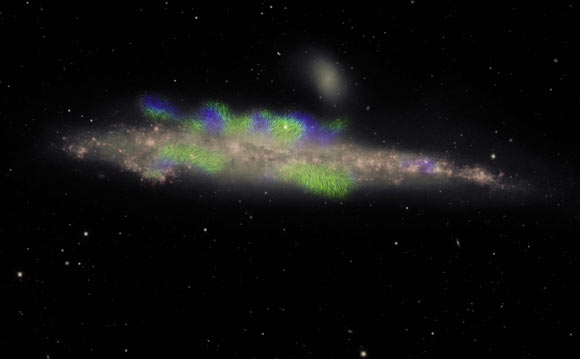Astronomers Spot Huge Magnetic Structures in ‘Whale Galaxy’ | Astronomy – Sci-News.com
Astronomers using NSF’s Karl G. Jansky Very Large Array (VLA) have captured a new image of the edge-on barred spiral galaxy NGC 4631 (also known as ‘Whale Galaxy’). The image reveals hair-like filaments of NGC 4631’s magnetic field protruding above and below the galaxy’s disk.

NGC 4631 is seen edge-on, with its disk of stars shown in pink; the filaments, shown in green and blue, extend beyond the disk into the galaxy’s extended halo; green indicates filaments with their magnetic field pointing roughly toward us and blue with the field pointing away; this phenomenon, with the field alternating in direction, has never before been seen in the halo of a galaxy. This VLA image shows a companion galaxy — a small elliptical galaxy called NGC 4627 — just above NGC 4631. Image credit: Jayanne English, University of Manitoba / Silvia Carolina Mora-Partiarroyo & Marita Krause of the Max-Planck Institute for Radioastronomy / Maria Patterson & Rene Walterbos, New Mexico State University / Arpad Miskolczi, University of Bochum / NRAO.
“This is the first time that we have clearly detected what astronomers call large-scale, coherent, magnetic fields far in the halo of a spiral galaxy, with the field lines aligned in the same direction over distances of a thousand light-years,” said Dr. Marita Krause, an astronomer with the Max-Planck Institute for Radioastronomy.
“We even see a regular pattern of this organized field changing direction.”
NGC 4631 is an interacting galaxy located approximately 25 million light-years from Earth in the constellation Canes Venatici.
Discovered by the British astronomer Sir William Herschel on March 20, 1787, the galaxy is about 80,000 light-years across, slightly smaller than our own Milky Way.
It has one of the largest gaseous halos observed among edge-on galaxies.
The new image of NGC 4631 indicates a large-scale, coherent magnetic field that is generated by dynamo action within the galaxy and spirals far outward in the form of giant magnetic ropes perpendicular to the disk.
“We are a little bit like the blind men and the elephant, since each time we look at the galaxy in a different way we reach a different conclusion about its nature,” said Dr. Richard Henriksen, a researcher at Queen’s University.
“However, we seem to have one of those rare occasions where a classical theory, about magnetic generators called dynamos, predicted the observations of NGC 4631 quite well.”
“Our dynamo model produces spiraling magnetic fields in the halo that are a continuation of the normal spiral arms in the galaxy’s disk.”
The image of NGC 4631 was made by combining data from multiple observations with the VLA’s giant dish antennas arranged in different configurations to show both large structures and finer details within the galaxy.
The naturally-emitted radio waves from the galaxy were analyzed to reveal the magnetic fields, including their directions.
“The techniques used to determine the direction of the magnetic field lines, illustrated by this image, now can be used on this and other galaxies to answer important questions about whether coherent magnetic fields are common in galactic halos and what their shapes are,” the scientists said.
“Building such a picture can answer important questions such as how galaxies acquire magnetic fields, and whether all such fields are produced by a dynamo effect. Can these galaxy halo fields illuminate the mysterious origin of the even larger intergalactic magnetic fields that have been observed?”
The findings were published in two papers in the journal Astronomy & Astrophysics and the Monthly Notices of the Royal Astronomical Society.
_____
Silvia Carolina Mora-Partiarroyo et al. 2019. CHANG-ES XV. Large-scale magnetic field reversals in the radio halo of NGC 4631. A&A 632, A11; doi: 10.1051/0004-6361/201935961
Alex Woodfinden et al. 2019. Evolving galactic dynamos and fits to the reversing rotation measures in the halo of NGC 4631. MNRAS 487 (2): 1498-1516; doi: 10.1093/mnras/stz1366





